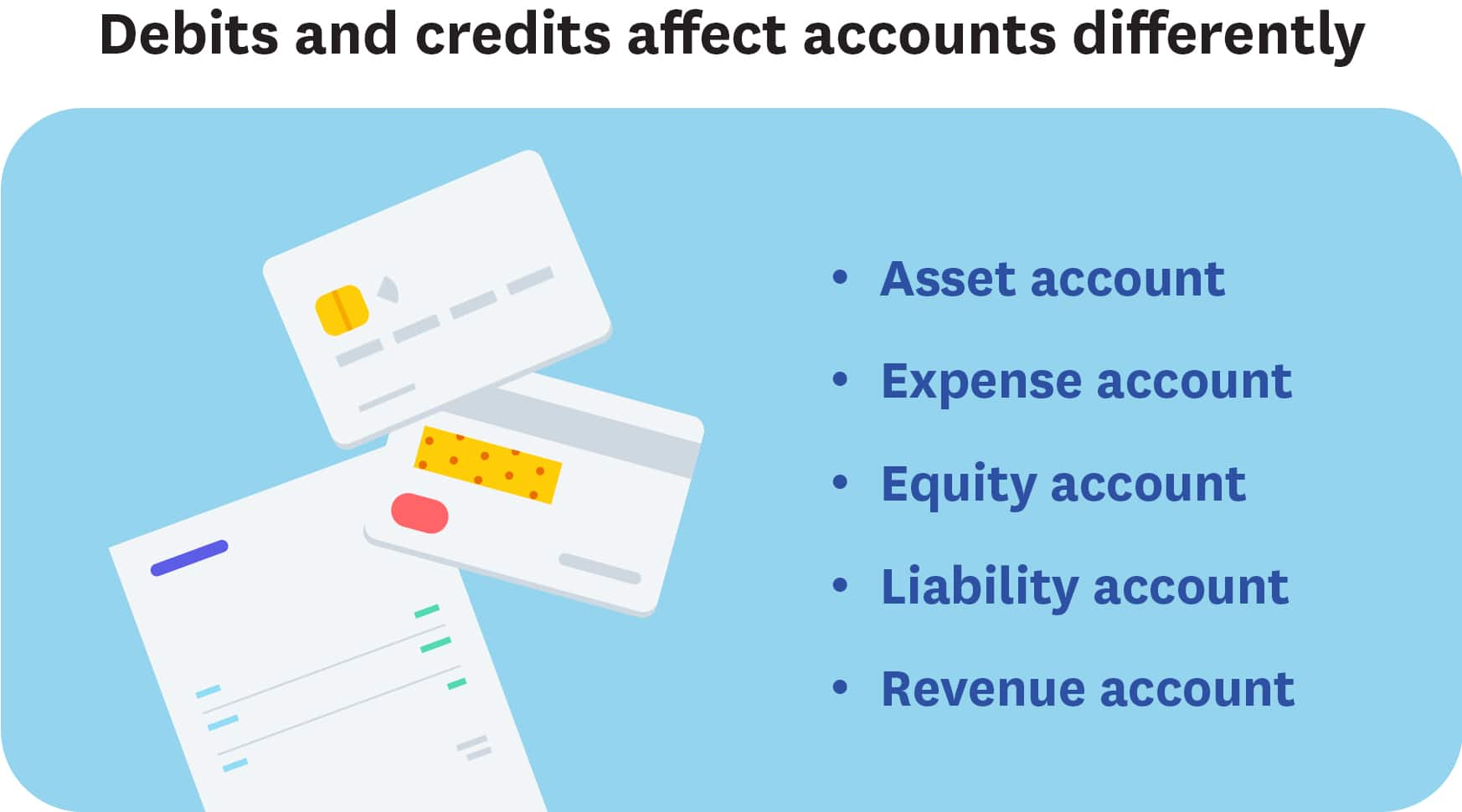Debits vs credits: Accounting rules explained for small businesses
Debits and credits form the foundation of double entry bookkeeping. Learn how they work together.

Written by Jotika Teli—Certified Public Accountant with 24 years of experience. Read Jotika's full bio
Published Friday 17 October 2025
Table of contents
Key takeaways
• Master the five fundamental rules of double-entry bookkeeping: debits must equal credits, debits appear on the left while credits appear on the right, debits increase assets and expenses while credits decrease them, and credits increase liabilities, equity, and revenue while debits decrease them.
• Apply the memory technique that debits increase Expenses and Assets, while credits increase Liabilities, Equity, and Revenue to quickly determine the correct entry for any business transaction.
• Calculate account balances using the T-account method by totaling all debits on the left side, totaling all credits on the right side, then subtracting the smaller total from the larger total to find your account balance.

• Recognize that when debits don't equal credits in your books, you must review and correct entries immediately to maintain accurate financial records that support loan applications, tax compliance, and investment decisions.
Defining debits vs credits

Debits record money coming into specific accounts and appear on the left side of your general ledger. Credits record money leaving accounts and appear on the right side.
This system uses double-entry bookkeeping, meaning every transaction requires both a debit and credit entry. Your general ledger tracks all these transactions to maintain accurate financial records.
The importance of debits and credits
Balanced debits and credits ensure your financial records are accurate and your books balance correctly. When debits equal credits, you maintain reliable financial data.
This accuracy provides critical benefits:
- Loan applications: Lenders review balanced books for credit decisions
- Tax compliance: The IRS requires accurate financial records, and for some items like employment taxes, you must keep records for at least four years.
- Investment decisions: Investors analyze balanced statements to assess business health, often using metrics like a company's P/E Ratio to evaluate its earnings relative to its stock price.
Debits and credits are the key to the double-entry accounting system. For it to work, you need a debit and a credit for each transaction. This keeps your books organized and your financial statements accurate.
Understanding double-entry bookkeeping
The concept of debits and credits is the foundation of double-entry bookkeeping. In this system, every transaction affects at least two accounts. One account receives a debit, and another receives a credit.
Think of double-entry bookkeeping as a way to keep your business's financial story complete. This method ensures that your books are always in balance. You get a clear and accurate view of your financial health. You can confidently track where your money comes from and where it goes.
Rules you need to know
5 fundamental rules govern how debits and credits work in all accounting systems. Master these rules to maintain accurate financial records:
- Debits must equal credits. In a double-entry bookkeeping system, this is essential for balancing your books.
- Debits are always on the left, and credits are always on the right.
- Debits increase assets and expense accounts. Credits are the opposite and decrease them.
- Credits increase liability, revenue, and equity accounts. Debits are the opposite and decrease them.
- Credits and debits have opposite effects and must equal each other in the corresponding account. For example, every debit has a corresponding credit and vice versa.
5 types of accounts and how debits and credits affect them
Five main account types organize all your business transactions in the general ledger. Each account tracks different aspects of your finances and can include sub-accounts for more detailed tracking.
The 5 essential accounts are:
1. Asset account
Asset accounts track everything your business owns that has value, from physical items to intangible assets. These are often classified; for example, current assets are items a company expects to convert to cash within one year.
You can add sub-accounts to help organize your asset account. Some common sub-accounts for assets include:
- Petty cash account
- Inventory account
The most important thing to know about the asset account is that a debit increases an asset account, and a credit decreases an asset account.
2. Expense account
Expenses are the costs you incur to run your business. These include wages, office supplies, advertising, and rent.
To further organize your expenses, you should create relevant sub-accounts for your business. Some common examples include:
- Insurance expenses
- Payroll expenses
- Rent
- Office expenses
Expense account rule: Debits increase expenses, credits decrease expenses.
3. Equity account
Equity refers to the net worth of a business, calculated by your total assets minus your liabilities. This figure is critical for analyzes like the debt-to-equity ratio, which shows how much debt a company is using to finance its assets compared with the amount of value represented in shareholders' equity. Examples of equity include the owner's equity, stock, and bonds.
Your equity account can be further organized into sub-accounts. Some common ones include:
When recording transactions in your books, a debit decreases an equity account, and a credit increases it.
4. Liability account
Liabilities are amounts your business owes but has not yet paid. Examples include sales tax you have collected and payroll tax.
You can further organize your liability account into sub-accounts. Some common sub-accounts include:
- Collected sales tax
- Payroll tax
When you record transactions in a general ledger, a debit decreases a liability account, and a credit increases it.
5. Revenue account
Your revenue account tracks all the income your business earns. Examples include sales revenue and earnings from investments.
Sub-accounts help you track where your main income comes from. You can also create sub-accounts within sub-accounts to organize your records. Tailor these to your business needs. Common sub-accounts include:
- Investments
- Product sales: Online sales
- Product sales: Store sales
When recording transactions in your general ledger, a debit decreases a revenue account, and a credit increases a revenue account.
How to remember debits and credits
Keeping debits and credits straight can feel tricky at first, but a simple memory aid can help. Many people use acronyms to remember which accounts are increased by debits and which by credits.
One popular method is to think about it this way:
- Debits increase: Expenses and Assets.
- Credits increase: Liabilities, Equity, and Revenue.
Grouping account types this way helps you quickly recall the correct entry for any transaction.
Calculating the balance
Calculating account balances requires adding up all debits and credits for each account, then finding the difference.
T-account structure
- Account name at the top
- Debits on the left side
- Credits on the right side
Balance calculation steps:
- Total all debit entries for the account
- Total all credit entries for the account
- Subtract the smaller total from the larger total
- The difference is your account balance
If the totals do not match, review your entries to find and correct any errors. This helps keep your accounts accurate.
Simplify your accounting with Xero
Managing debits and credits does not have to be complicated. Xero accounting software automates the double-entry process, matching debits and credits for every transaction.
Key benefits include:
- Automated entries for every transaction
- Built-in checks to keep your books balanced
- Real-time updates to your account balances
- Accurate records without the complexity
Ready to simplify your bookkeeping? Try Xero accounting software for free and see how easy accurate accounting can be.
FAQs on debits and credits
Check out these common questions and answers about debits and credits for small businesses.
Is a debit money in or out?
It depends on the account. For an asset account like your bank account, a debit means money is coming in. For a liability account like a loan, a debit means you have paid money out, reducing what you owe.
What are the 7 rules of debit and credit?
The rules are based on the five main account types. Debits increase asset and expense accounts, while credits decrease them. Credits increase liability, equity, and revenue accounts, while debits decrease them. Debits are on the left, credits are on the right, and they must always balance.
What is the easiest way to remember debits and credits?
A simple way is to remember that debits increase asset and expense accounts. For all other accounts—liability, equity, and revenue—credits cause an increase. Focus on what each one increases to make it easier to recall.
How do you know if an account should be debited or credited?
First, identify the accounts involved in the transaction. Then, determine the type of each account (asset, liability, and so on). Finally, decide if the transaction increases or decreases the account's balance and apply the correct debit or credit rule.
What happens if debits don't equal credits?
When debits and credits balance, your financial reports are accurate. If they do not, review your entries to find and correct any mistakes. This keeps your books reliable.
Disclaimer
Xero does not provide accounting, tax, business or legal advice. This guide has been provided for information purposes only. You should consult your own professional advisors for advice directly relating to your business or before taking action in relation to any of the content provided.
Get one month free
Sign up to any Xero plan, and we will give you the first month free.